
Most transportation systems and companies have defined elements of their sustainability strategy and launched initiatives related to improving efficiency and strengthening resilience. However, we believe these concepts — sustainability, efficiency, and resilience (SER) — should be considered not in isolation but with a holistic and integrated view.
Transport and mobility companies must acknowledge that SER goals are not always compatible and can hamper strategic business objectives, leading to misalignment across stakeholders and organizational inertia. Instead, the aim should be to use a systematic approach to strike a balance among these three often competing areas, identifying areas of mutual benefit to maximize the positive impact to the business.
DEFINING PRIORITIES FOR THE COMPANY OF THE FUTURE
We live in a world where change is increasingly fast-paced, constant, and unpredictable, driven by a wide range of interrelated trends. Examples are not hard to find: the COVID-19 pandemic has caused huge disruption in the transport sector, geopolitical challenges are ever more present and unpredictable, and the ongoing energy crisis is stressing global economies and supply chains. Transport and mobility systems are under increasing pressure to deliver in this context. To survive and grow, transport systems and companies must become more:
-
Sustainable — being inclusive and socially geared in meeting the access and development needs of society while minimizing impact on both human and environmental health. Many transport systems and companies are working to reduce their carbon footprint and create more long-term value as passengers, regulators, and governments demand more sustainable mobility. The ongoing energy crisis has brought this into even sharper focus.
-
Efficient — delivering the output required with reduced or minimal expenditure, resource consumption, and use of human capital. Efficiency goals are further complicated by transportation systems typically being asset- and energy-intensive, and many companies have an aging asset base with significant capital budgets required to maintain or replace them.
-
Resilient — operating in the face of multiple threats and disruptions, such as extreme weather, collapse of key supply chains and energy supplies, loss of service, or incidents. The companies that comprise a resilient transport system must be able to anticipate opportunities and threats to ensure they can survive rapid changes in demand and use patterns. The COVID-19 pandemic and ongoing recovery have highlighted the importance of resilience.
Many companies we have spoken to are struggling to tackle the interrelated challenges between these high-level SER goals. Nearly all companies have specific plans and objectives relating to these individual goals, but they are too often considered in isolation, with different senior managers accountable for them and a lack of holistic governance and communication. For example, transport companies have carbon-zero strategies to varying levels of maturity, typically led by a sustainability director, that place significant demands on all aspects of the business going forward, including operations, engineering, asset management, and supply chain — from providing low-carbon energy to power vehicles to ensuring communities get fair and equal access to transport services.
Transport companies are not new to risk management, and some are embracing the broader topic of resilience, including operational resilience (the transport system has a high level of redundancy and can continue to operate effectively with multiple disruptions, such as alternative routes and power supplies) and financial/business resilience (the system and constituent companies can continue to function with rapid changes to demand and revenue, such as by having multiple diverse sources of revenue). However, resilience is growing in relevance and necessity. For example, in October 2022, the EU Commission instructed member states to carry out stress testing on transport infrastructure after the sabotage of the Nord Stream gas pipelines as part of an effort to increase the resilience of critical infrastructure.
Efficiency gains will often take the form of initiatives to reduce head count, extend asset life, and so on, rather than necessarily being under the governance of a single part of the organization.
Activities under these different goals are rarely integrated but can often undermine each other, so companies and systems are often left with dilemmas and tradeoffs (see sidebar, “Dilemmas & tradeoffs — Examples”).
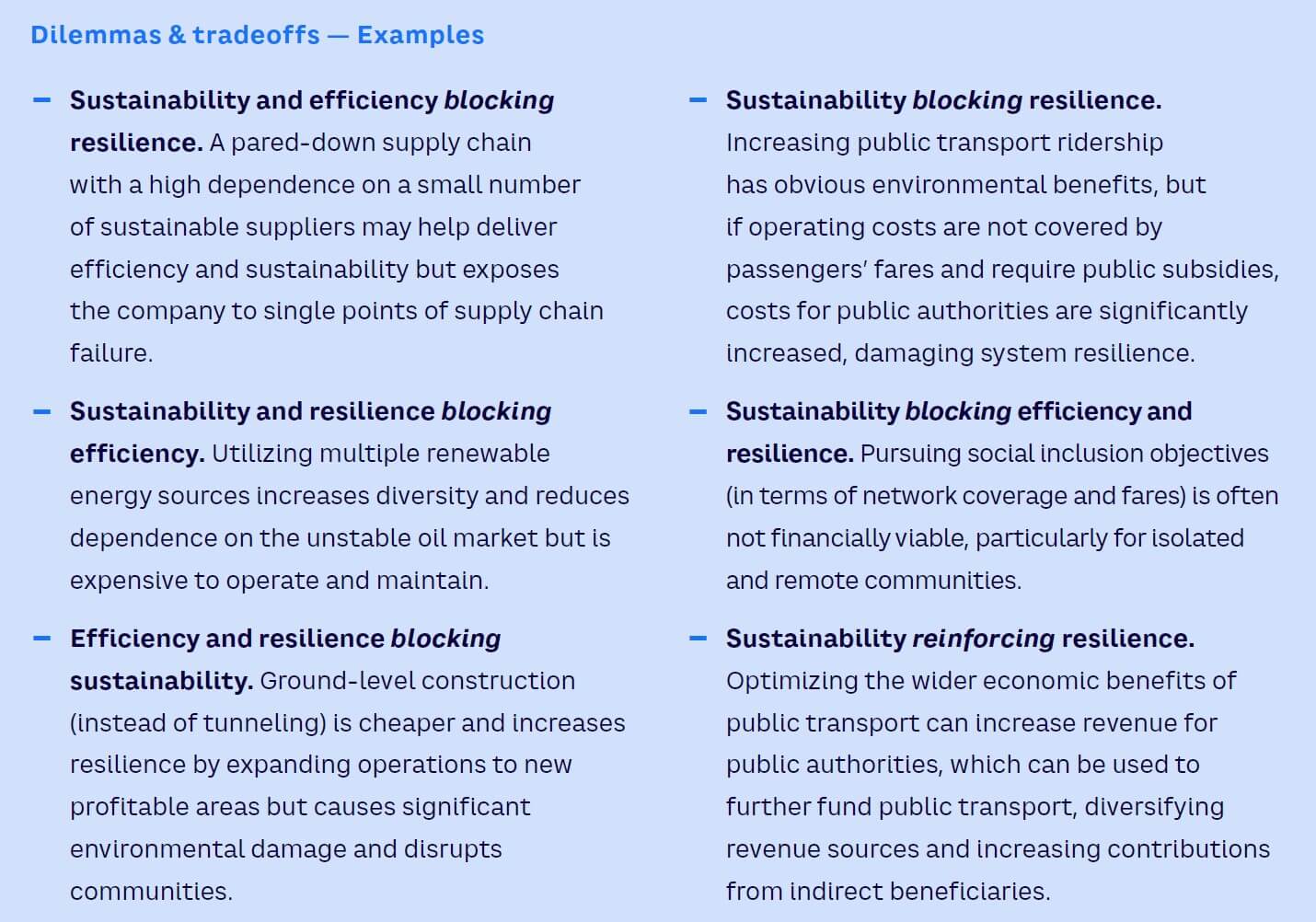
The solutions to these conflicts are often multifaceted and nontrivial. How can a balance be achieved, and the overall position improved, while keeping the internal and external stakeholders happy? How can SER objectives be analyzed to identify tensions (reinforcement/opposition) and maximize benefits in terms of overall impact as well as time to impact? Arthur D. Little (ADL) has developed an SER framework and approach that can help a company to identify the issues and opportunities that either block or accelerate an organization’s ability to achieve its strategic objectives and deliver on its commitments, as well as take action to ensure long-term success.
FROM ESG TO SER
All companies are familiar with the strategic importance of managing environmental, social, and governance (ESG), prompting them to define ESG strategic objectives and corporate commitments to varying degrees of maturity and sophistication and in line with internal capabilities and priorities. Some have created detailed plans and are committed to action, while others have outlined future aspirations that are not yet concrete. However, strategic objectives for ESG often compete with efficiency and resilience goals (see Figure 1).
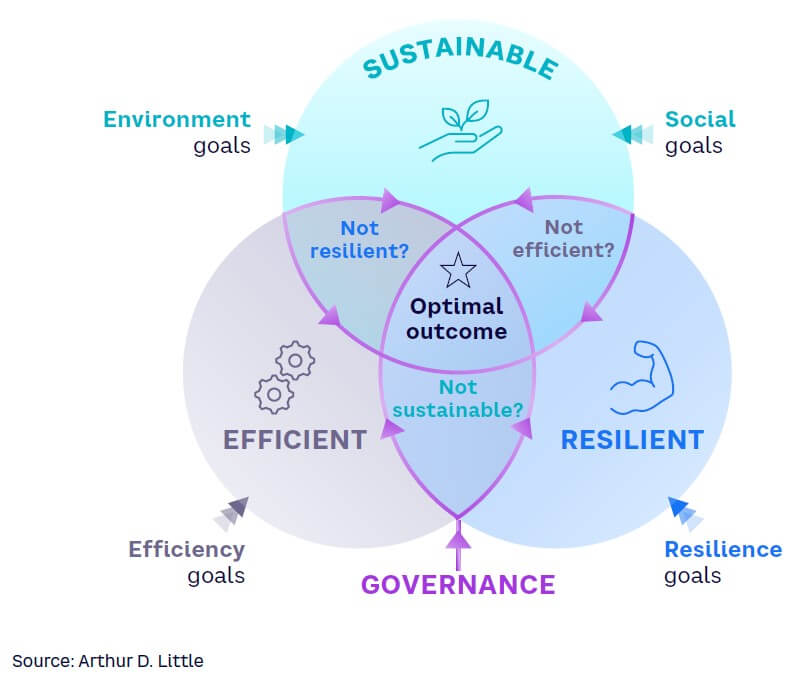
ADL’s SER framework builds on ESG (effectively ESG++) by taking existing plans, frameworks, and strategies and reconciling them to remove conflicts so that companies can meet strategic objectives and commitments without compromising overall efficiency and resilience aims. It is likely that it will be necessary to revise or adjust specific delivery objectives to achieve this goal. Failure to meet public commitments to sustainability, imposed efficiency measures, or to be sufficiently resilient to survive the next “COVID event,” however, are significant reputational and, in some cases, existential risks all transport systems and companies face. The key question is, can a transport system or company survive, and thrive, if any of the S, E, and R dimensions are not delivered upon?
THE SER FRAMEWORK
As the three high-level pillars of SER are not new in isolation, plans, frameworks, and strategies exist to address specific elements under each of the pillars, some of which have been subject to cost/benefit analysis. It is neither feasible nor desirable simply to replace these plans, so conflicts must be carefully managed to ensure they can support the achievements of strategic objectives and stakeholder expectations. The SER framework allows transport companies and authorities to consider the three pillars holistically and in an integrated fashion, aiming to increase the chance of system and company success across the three areas through a more integrated approach and improving the opportunities for identifying and acting on appropriate synergies.
The framework takes an organization’s specific goals across the three pillars of SER and includes 20 generic goals in the areas of environment, social, efficiency, and resilience that we expect will align with most transport companies’ existing plans, frameworks, and strategies (see Figure 2). These goals are then operationalized through effective governance arrangements, when tensions, blockers, and enablers can be uncovered. Helpfully, the approach can identify key enablers as well as blockers. Multiple enablers are important, as any plans or objectives that can positively contribute to all three high-level SER pillars are likely to be an obvious choice. For example, transport systems that embrace mobility as a service (MaaS) may find ways to combine benefits across all three pillars: improved sustainability through social inclusion (through easing access to and understanding of multiple mobility actions) and reduced environmental footprint (through fostering a shift to more environmentally friendly transport modes); increased efficiency (by optimizing mobility flows at system level, including ensuring a better utilization of assets); and increased system resilience (through improving choice and ease of use of multiple mobility options by providing real-time multimodal information considering user preferences and prevailing circumstances).

It is not the aim of the SER framework to comprehensively cover all the objectives of a transport system or company. Many transport companies will have strategic objectives relating to other key areas such as growth, quality, and customer experience. However, these objectives are often closely linked or highly synergistic with SER objectives, and successfully reconciling tensions within SER will improve the likelihood of meeting other critical business objectives (e.g., improving system resilience often leads to more reliable service, which improves customer experience, leading to higher satisfaction and loyalty, and ultimately leading to increased revenue streams, and so on). Successfully managing competing objectives in a dynamic environment will require the development of strong, holistic, and cross-functional governance arrangements to drive and oversee progress. Therefore, the fourth element of the framework is governance, which underpins the three SER pillars.
PUTTING THE FRAMEWORK TO WORK
Applying the SER framework involves deploying a four-stage process (see Figure 3). The framework can be applied as a one-off diagnostic to act as a trigger for business planning decisions, or it can be integrated into the wider business planning cycle and used routinely (including continuous monitoring and reporting).
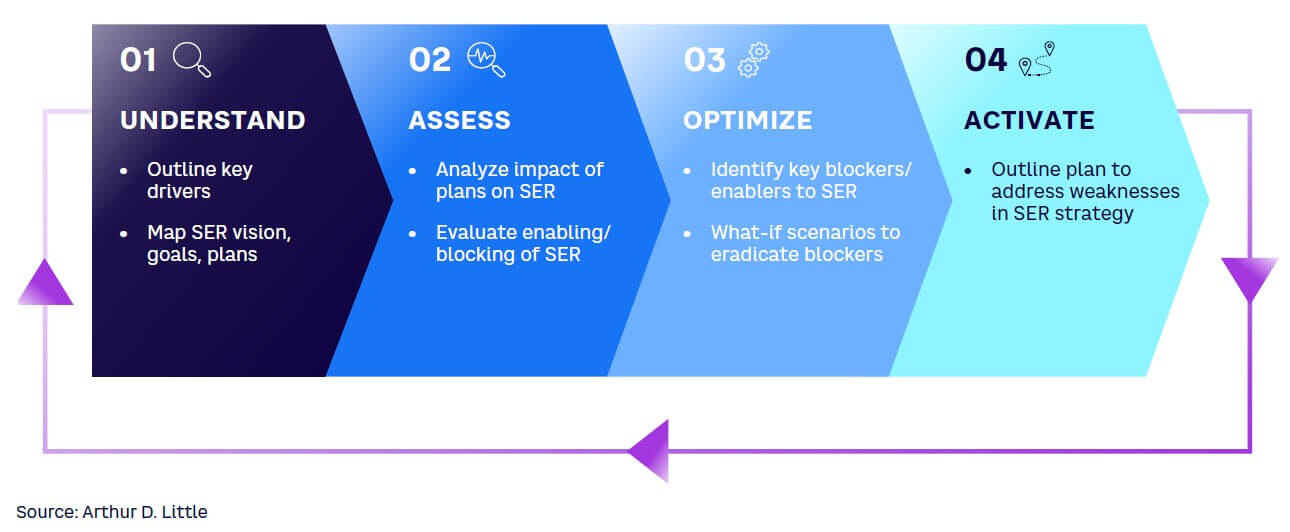
Understand
The first step is to understand the current position and what is already planned. This means mapping all external/internal drivers and collecting and collating individual SER visions, goals, and plans. At a high level of abstraction, these goals are likely to be similar for all transport organizations, such as achieving net-zero carbon by 2050. Where they will differ is in the delivery plans used to achieve them. Some companies will have specific plans, such as a switch to 100% renewable power or retiring old rolling stock. Some companies may not yet have tangible or realistic plans, and the way they plan to achieve their high-level goals remains to be determined.
Assess
Once the delivery plans have been collated, they need to be assessed under their respective SER pillar. Companies can rate each specific delivery objective in terms of its:
-
Scale of delivery and application. How ambitious is the plan? For the part of the system in which it is being implemented, what percent of revenue, emissions, resource consumption, workforce, people, and service are affected? How much of the transport system is the plan targeting? This could range from a pilot program to a full global rollout.
-
SER interaction. How does each delivery objective interact with the high-level sustainability (environment, social), efficiency, and resilience goals? Do they block or enable SER?
Once each specific delivery objective under the high-level SER goals has been rated, companies can use the SER heatmap to identify where tensions and blockers exist (see Figure 4).
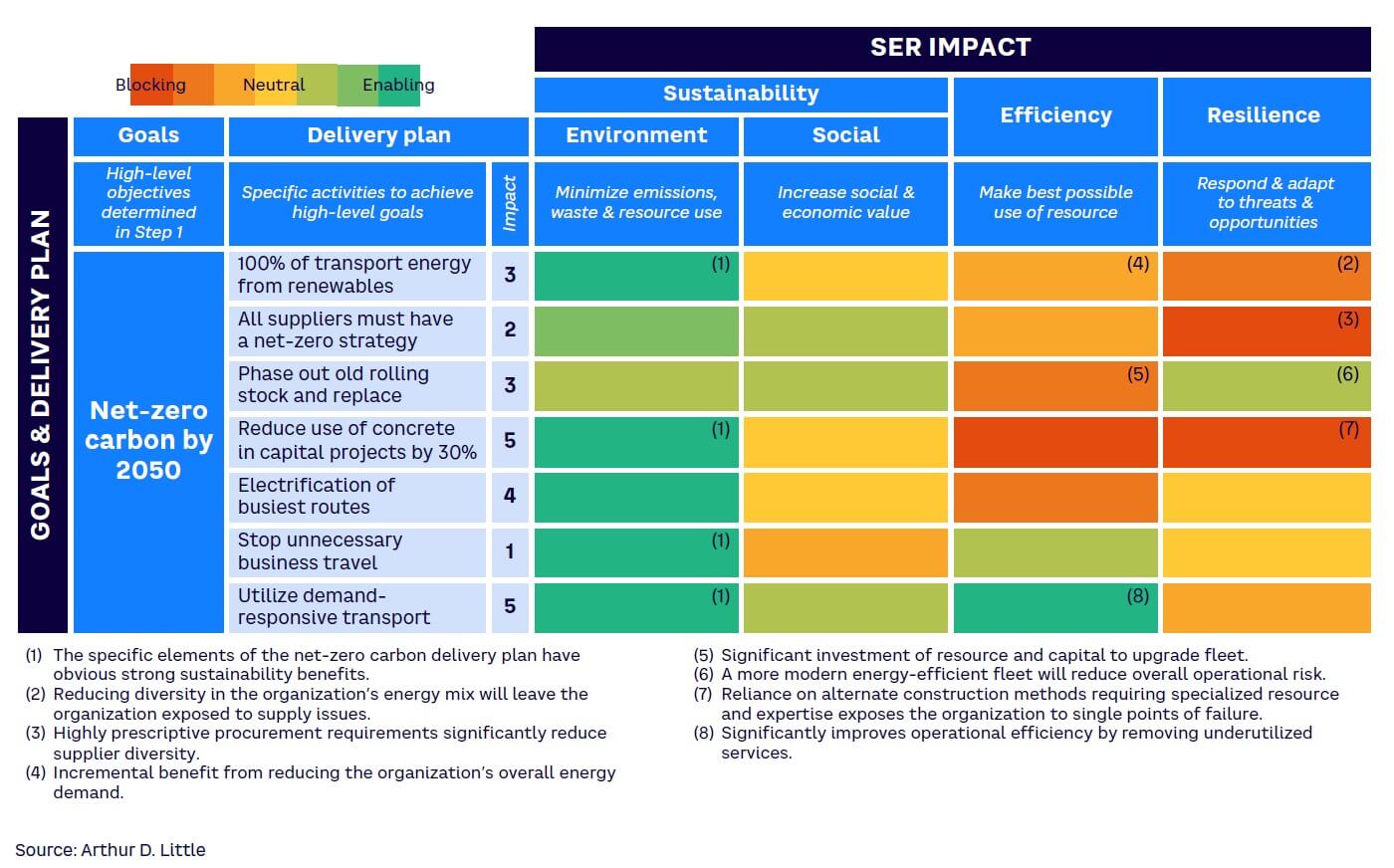
Optimize
By analyzing the results of the assessment, companies can identify where current plans may block the achievement both of specific SER pillars and individual goals. An SER dashboard can be used to highlight and understand areas of concern. The company can then use scenario modeling to target the removal of key blockers. Optimization decisions must factor in any current progress/investment in specific plans and the impact of external drivers (e.g., legislation) on the flexibility of plans.
Activate
Understanding what needs to be changed to remove blockers can look simple in theory, but when put into practice, complications and conflicts will inevitably arise. Solutions to the problems caused by tensions between sustainability, efficiency, and resilience are often multifaceted and span large elements of the organization.
The SER framework is likely to uncover a wide range of blockers across all high-level goals. Therefore, companies should start by creating a roadmap that addresses all blockers and their relative impact. The removal of high-impact blockers should be prioritized, although the complex nature of transport operations and the maturity of existing corporate strategies and commitments mean it is unlikely to be possible to remove all blockers from all high-level goals. Organizations must also create new strategies to mitigate/minimize other significant blockers that cannot be removed. (For examples, see the sidebar, “Management of opposition & reinforcement — Three examples”).
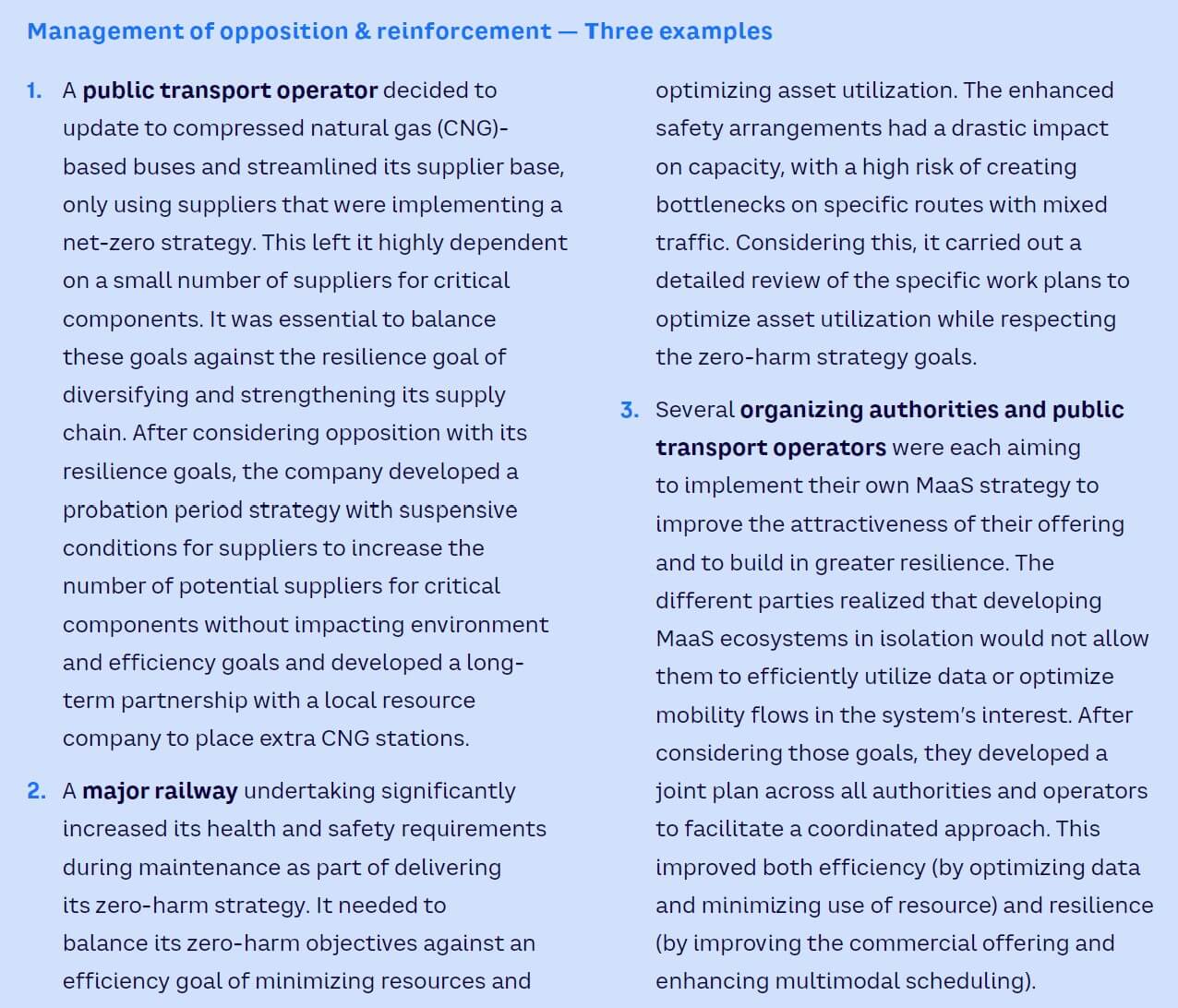

MOVING TO THE END STATE: GETTING IT RIGHT
The need for robust governance
Because transport companies and systems are functioning in a fast-changing world, SER calibration must be an ongoing activity. It therefore requires the development of strong, holistic, and cross-functional governance arrangements to drive and oversee progress. Companies that implement the SER framework are likely to have to change their organizational structure and decision-making processes to ensure competing S, E, and R objectives are robustly and consistently balanced. Individuals or committees with holistic oversight over the three different SER strategies can avoid the siloed decision making many companies have today, where the impact of SER initiatives on other strategic objectives is not visible to or considered by key stakeholders.
When creating new governance arrangements, it is important to design efficient and effective committee structures to avoid duplication and inertia, while maintaining agility within the organization to deliver its strategic goals. Individuals and committees need a degree of authority to act and require the setting of clear terms of reference, roles, and responsibilities, with predefined escalation rules to ensure there is accountability and visibility over the SER framework and that adjustments can be made in a timely manner. Therefore, a comprehensive approach to SER involves embedding the framework in the organization, conducting the exercise multiple times as part of the annual planning process, and making sure accountable individuals have the visibility and authority to influence strategy to remove tensions and blockers and promote reinforcement across the three pillars.
The right level
In practice, material changes to organizational governance are nontrivial, expensive, and time consuming. However, the SER framework can still be used to add value without full deployment and significant changes to governance. A one-off exercise, focused on a specific company (or even division or business unit) or subset of objectives, can identify opposition and reinforcement relatively easily and be used to identify both short- and long-term actions to better the company’s overall position (and will not require going through the four-step process). Another approach is to use the SER framework as a tool to enhance and reinforce the robustness of the ESG strategy, ensuring the company meets its ESG commitments while positively impacting efficiency and resilience. This approach will inform the ESG strategy without requiring significant changes to organizational governance.
The right timing
Recent years have seen significant changes in the relative importance of sustainability, efficiency, and resilience to key stakeholders in transportation systems. For example, the opening of the European national rail market in 2016 led to many companies focusing on increasing customer satisfaction and reducing costs to fight growing competition from long-distance operators. However, over the course of a few years, with escalating pressure from environmental groups (e.g., Fridays for Future) and new European legislation, environmental sustainability moved up the list of priorities until it was seen as the key issue by many companies in Europe. The COVID-19 pandemic meant that most European rail and infrastructure providers had to refocus on efficiency, as demand declined significantly. Today, in post-COVID Europe, the combination of increased demand (exacerbated by government environmental schemes in response to the ongoing energy crisis, such as Germany’s 9-Euro ticket pass), supply chain interruptions, and high inflation has brought the need for resilience into sharp focus and put significant pressure on efficiency, be it energy sources, other parts of the supply chain, or cybersecurity.
With the benefit of hindsight after a significant change in external context, it is easy to say the right timing for the SER exercise would have been before the events unfolded. Clearly, there are significant benefits in integrating the SER framework into the annual planning cycle, but fortunately, there are other ways to benefit from the SER framework as well. As recent experience in the European rail and mobility markets shows, if companies or systems have not yet fully assessed the scale and impact of their plans on the SER pillars, the best time to start is always now, even if budgets and planning are close to being finalized. The relative priorities of SER constantly change, and significant changes in external context are never far away. There is always a benefit from considering different scenarios, trigger points, and contingency plans.
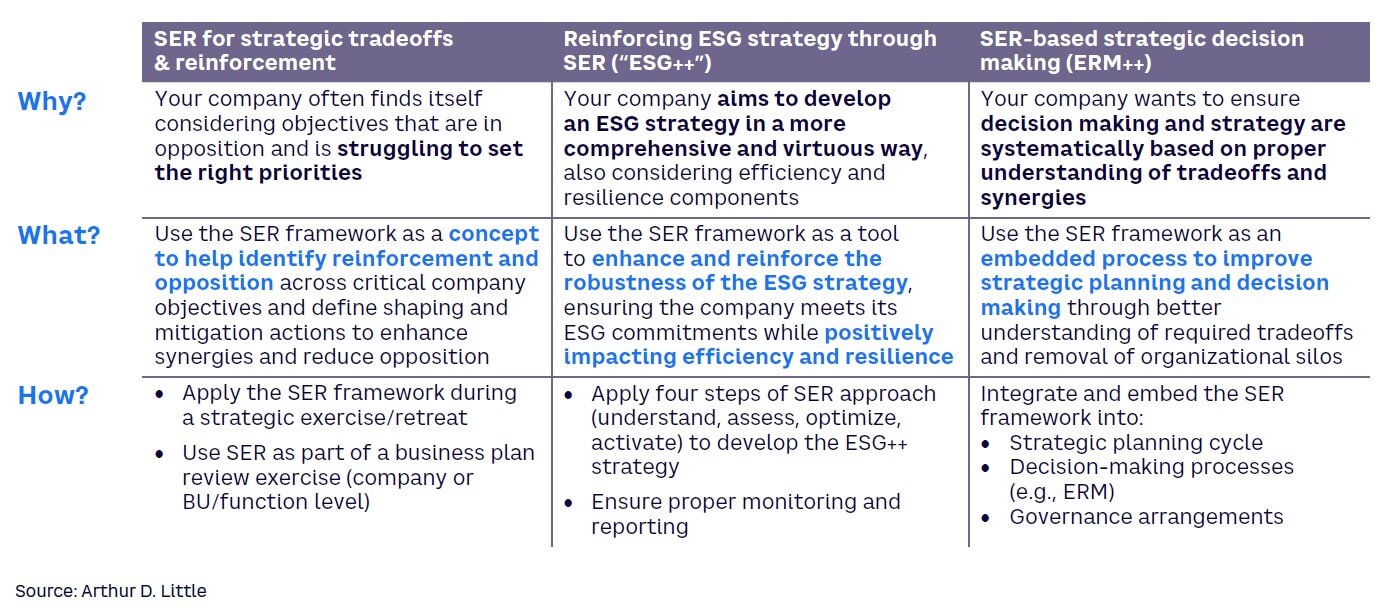
Conclusion
NAVIGATING THE PATH AHEAD
At the individual organization level (i.e., transport operator or infrastructure manager) as well as at the system level (transport authority or city), transport ecosystems must manage a growing number of priorities, requiring a holistic and integrated approach. In short:
-
The SER framework can enhance an organization’s ability to achieve strategic objectives and deliver on its commitments by maximizing reinforcement and handling opposition across critical company objectives, allowing for acceleration of alignment for optimal outcome and long-term success.
-
The SER framework can be used comprehensively as an embedded process to improve strategic planning and decision making through better understanding of required tradeoffs and removal of organizational silos, requiring changes to governance arrangements.
-
The SER concept also works as a tool to enhance and reinforce the robustness of the ESG strategy (i.e., ensuring the company meets its ESG commitments while positively impacting efficiency and resilience) or as a one-off exercise to identify opposition and reinforcement among critical objectives and pinpoint concrete improvement actions to refine the overall position.




